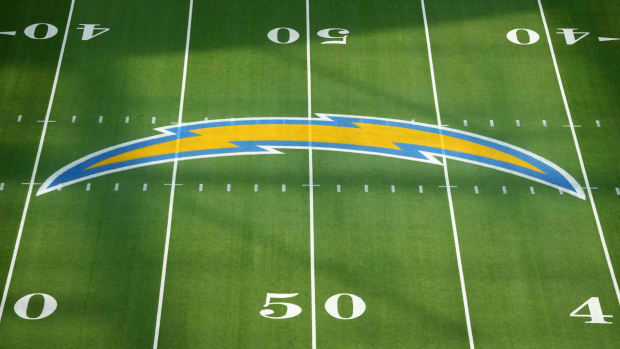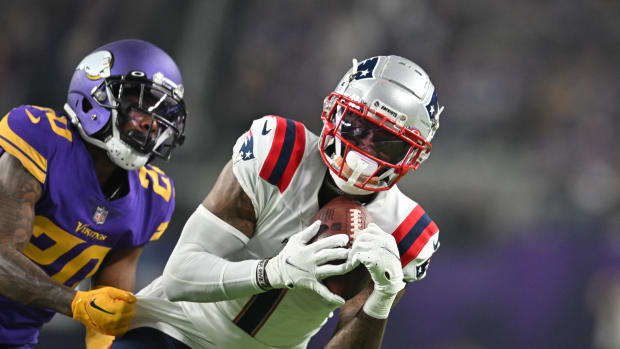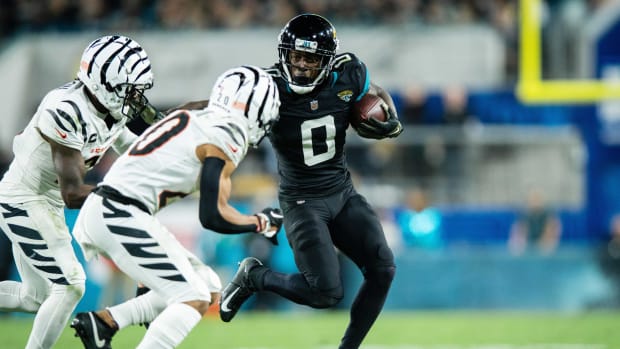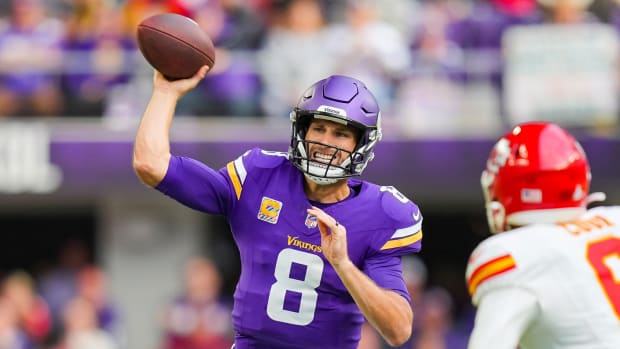SI 64: No. 7: Alabama WR Amari Cooper
With the 2015 NFL draft fast approaching, it’s time for all 32 NFL teams to start getting their draft boards in order and ranking players based on their own preferences. At SI, it’s time for us to do that as well. To that end, Doug Farrar and Chris Burke have assembled their own definitive Big Board, consisting of the players they feel deserve to be selected in the first two rounds.
• The SI 64 (so far): Counting down top prospects in the 2015 NFL draft
Alabama's Amari Cooper is considered by many as the top receiver in the draft. Will NFL teams agree?
Bio: Nevada's Trevor Insley holds the Division I-A/FBS single-season record for receiving yards, with 2,060. Had Amari Cooper not been held in check by Arkansas last October (two catches for 22 yards) or been rested during much of a November blowout win over Western Carolina (three catches for 46 yards), the Alabama superstar might have made a serious run at Insley's mark.
As it was, Cooper led the nation last season in receptions (124) and finished second in receiving yards (1,727), plus added an SEC-best 16 touchdowns. All that came en route to the Biletnikoff Award, handed out annually to college football's best receiver, and a third-place finish in Heisman Trophy voting.
And yet ...
"I think I can be more consistent in everything that I do," Cooper said. "There were definitely times when I didn't look the ball all the way through when I should've ... definitely times when I could've high-pointed the ball, and again could've made my numbers look better."
He may be his own harshest critic. There was little to nitpick during Cooper's three-year Crimson Tide career, which started in 2012 when he shattered several of the program's freshman records. His 59 catches, 1,000 yards and 11 touchdowns that season all set new marks, breaking the ones previously held by Julio Jones.
After being selected No. 6 overall by Atlanta in 2011, Jones has continued racking up numbers in the NFL. Prior to Jones the last Alabama WR drafted in Round 1 was Dennis Homan, way back in 1968 by Tom Landry's Cowboys. (Joey Jones was a first-round pick in the 1984 supplemental draft.) Cooper will ensure that the Crimson Tide's wait is not nearly as long this time around—he is all but assured of being taken early on the draft's first day.
"I certainly want to be the best receiver, not just in this class, but overall, wherever I go," he said, "and I'm going to work hard to try to be that."
Strengths: There is always a learning curve for players jumping from college to the NFL, but Cooper shredded NCAA defenses by showing a brilliant feel for his routes. As was the case on several long touchdowns, Cooper can put his foot in the ground and burst into open space for his quarterbacks. The real edge he creates, though, is in his ability to force defenders off-balance.
2015 NFL Mock Draft 4.0: Running backs on the rise in Round 1
"You don't want to give the defensive back any signals about what route you're going to run," Cooper said. "Every time I run a route, I try to make it seem like I'm running a different route than I'm actually running so I can get open."
That aspect of his game shows up time and again. So, too, does his ability to get off the line against physical cornerbacks. While he is not overwhelmingly strong at 6'1" and 213 pounds, Cooper uses his hands well and is shifty enough to shake past half-hearted press attempts. As Alabama's QBs no doubt appreciated, Cooper also showed little to no hesitation across the middle, willingly taking hits to make plays. He displays a noticeable knowledge for his position. Rarely is Cooper content to run his route and shut it down if he's not open; instead, he stays active and can find soft spots in coverage. Just another plus in a well-rounded game.
• PERLOFF: Learning to see the game like an NFL scout
Weaknesses: Despite his 16 touchdown catches last season, Cooper may never be dominant in a "big receiver" role—i.e. he'll get open through his routes, instead of manhandling a CB physically or winning a bunch of jump balls. That should not create too much panic over his skill set inside NFL war rooms, but it is noteworthy when comparing him to Kevin White and DeVante Parker, both of whom excel at going up for the football.
50 essential, eccentric facts about the 2015 NFL draft
Cooper has some occasional issues with drops—he had 13 over the past two years. Chalk those minor mistakes up to focus, and it circles back on that consistency comment from Cooper above. The average strength can be a detriment when Cooper is asked to run block, though he usually holds his own in that regard.
Conclusion: Any issues with Cooper's game are negligible. The strengths are off the charts. White and Parker are exceptionally skilled, yet it's Cooper who arguably stands out most as the receiver in this class capable of making a substantial Week 1 impact. His game is that polished already, and it should only continue to grow sharper as he spends some time with a professional quarterback. Those 124 catches last season came mostly off the arm of Blake Sims, a fellow 2015 draft hopeful whom many believe will have to switch positions if he wants any semblance of an NFL future.
Cooper is not a stone-cold lock to be the first receiver taken in 2015. Should he slip out of the top 10 picks, however, it would be a surprise—and probably a mistake by those teams opting to look elsewhere.
Player comparison: Jordy Nelson, Packers (Round 2, 2008)




































